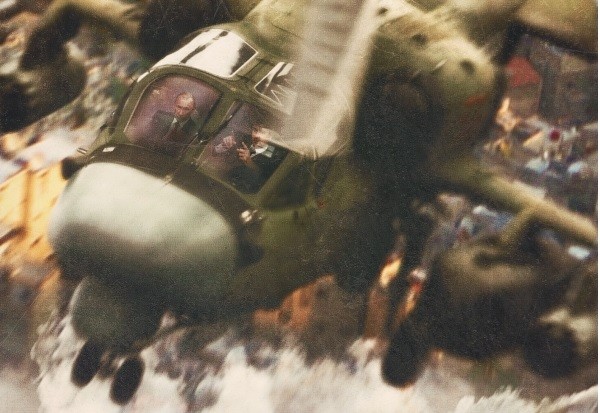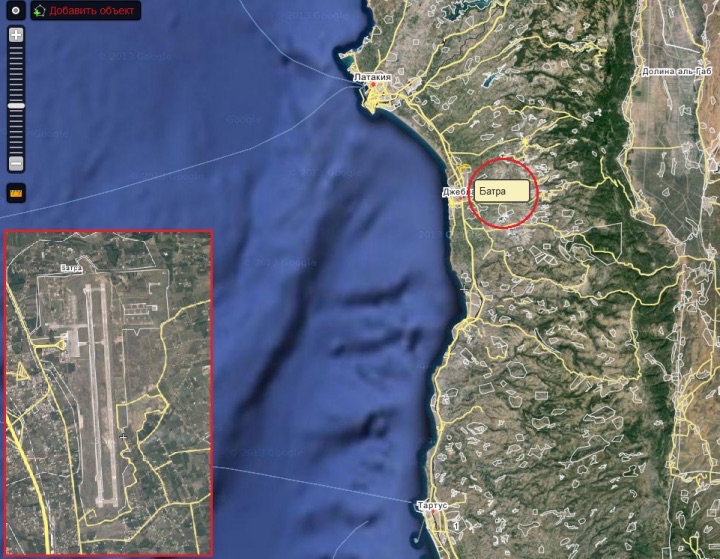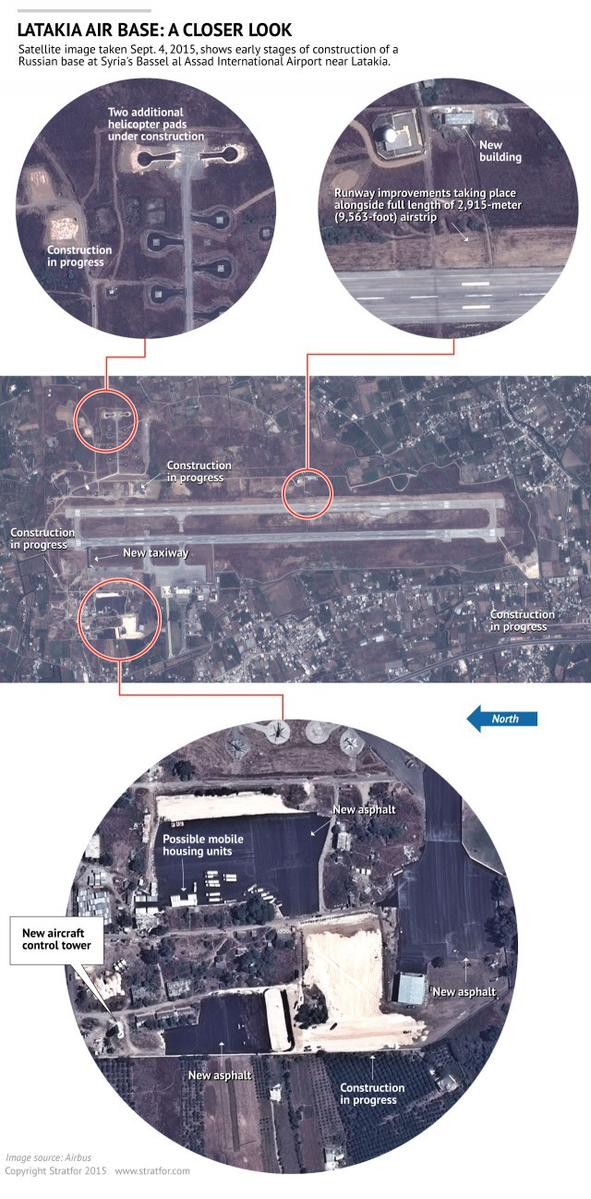We would like to remind the readers that the Western journalists and the Russian restless Fifth Column both aim at proving by all means the Russian servicemen's presence in Syria. Being unable to present any direct evidence thereof, "the debunkers" chose to recourse to their favourite technique - reading tea leaves.
One of the "researchers" Ruslan Leviev, for instance, made an error having placed a bet on the Russian marines - alas, their presence on the board of the large landing ship as well as at the Syrian port Tartus is nowhere close to a sensation being totally legal and regulated by Order 321 from 23 August 1997. Moreover, it is our army's duty to protect military facilities abroad, so even finding the Russian marines on the airfield 5 kilometers from Latakia will hardly be a scoop. Sorry, Ruslan, a wrong shot.
Meanwhile, the Western media have been taking wild guesses over the course of the last two weeks, spitting into the informational space dozens of conjectures and proofs of the Russian military presence in Syria. A good half of the material is a fake, a part of it is versions and the rest is "information from reliable sources". Nonetheless, having such a variety of ideas, the Western journalists in a probabilistic sense had a good chance to make a correct guess and hit the target. Let us recall their principal versions and proofs:
- Russia delivers to Syria 6 MIG-31 fighters-interceptors (the Turkish media, the middle of August).
- Russia deploys military aircraft with the Russian crew near Damascus (the Israeli media, the end of August).
- Russia is forming striking troops of a thousand of soldiers near Damascus (the Israeli media, the end of August).
- The Russian aircraft with the Russian crew bombs the positions of the Islamists (the Israeli media, 1-2 September).
- The Russian language is heard speaking among the Syrian troops near Latakia and Hama (the Lebanese media, 2-3 September).
- Russia is constructing a military base near Damascus (the Israeli media, 2-3 September).
- The FCA fighters meet more and more Russians siding with the government troops (the British media, 5 September).
- Russia is constructing a military base in Latakia (the Israeli and American media, 5-11 September).
- Russia moves thousands of soldiers to Latakia (the American media, 6 September).
- Russia is preparing for a large-scale operation against the Islamist fighters (the American media, 6-11 September).
- The Syrian army backed by the Russian troops launches an offensive in Latakia (the Lebanese media, 8-10 September).
This information, presented by some Israeli and American media and initially treated with certain skepticism, has now been proved by the report of the American private analytical agency Stratfor known around the world as "the shadow CIA". Here is a quotation from this report:
Satellite imagery of the Bassel al Assad international airport near Latakia confirms the information of Russia performing military-transport flights to this airfield where the Russians have allegedly been constructing a base. The satellite imagery taken on 4 September shows a newly built aircraft control tower, new asphalt, and containers presumably used as mobile housing units. Construction work is under way on the whole territory of the airport. There are traces of excavations alongside the full length of the runway. Most likely, the airport is being prepared for servicing heavy transport aircraft.As can be seen in the satellite image, the following infrastructure facilities are currently under construction:
- helicopter pads;
- taxiways;
- an aircraft control tower;
- mobile housing units.
The runway expansion work suggests that the airfield is planned to receive heavy aircraft on a regular basis. Stratfor notes: "Having built an airbase, Russia will have far more possibilities to back up the government troops providing them with air support". Expanding the runway might serve a different purpose, though - the simultaneous take-off of several aircraft.
Comment: We wouldn't go so far as to say that Stratfor's analysis 'proves' that this is the start of a Russian airbase. From Sputnik:
According to Russian former head of the International Treaty Directorate of the Defense Ministry Lieutenant-General Yevgeny Buzhinsky, construction of the Russian air base near Latakia is disadvantageous as it would require spending considerable time and resources, which seems unreasonable in the current conditions.
"There is no sense in creating a military air base there (Syria). Judge for yourself: it is a very expensive and technically complex thing that cannot be done in just a few months," the expert said.
The spokesman did say that the Russian side could well assist Syria in the reconstruction of the field aerodrome, the aim of which would be receiving humanitarian aid.
"If our military is doing anything over there, it is likely that it is connected with the renovation of the runway to receive aircraft with cargo, including humanitarian aid," Buzhinskiy said.
It was reported that the installation of new lighting and radio equipment on the airfield and reconstruction work on the runway is underway in Latakia.
Buzhinsky stressed that the reconstruction of the runway in Latakia is justified, in view of the increasing threat of ISIL terrorists taking over Damascus airport.
The former Chief of the Main Directorate of International Military Cooperation of the Ministry of Defense of the Russian Federation, Leonid Ivashov, said that the statement released by the Pentagon is mere propaganda and is not supported by actual facts.
"As far as I know, there are no plans to create an air base near Latakia. It is fictional Western propaganda. Building military installations and signing agreements on military-technical cooperation with sovereign states is our legitimate right and no one has the right interfere in that," he said.
The first indirect evidence of the Latakia airfield being renovated appeared on 6 September; it was Alexander Tkachenko ferry going through the Bosporus with several dozens of army fuel drums and fire engineering on board.
The next day first Russian transport aircraft was noticed landing at the Bassel al Assad airport. Here are all the flights that have been registered so far in the chronological order:
- 7 September - An-124 (RA - 82039) Chkalovskyi - Latakia;
- 7 September - Il-62M (RA - 86496) Chkalovskyi - Latakia;
- 8 September - An-124 (RA - 82035) Pskov - Mozdok - Latakia;
- 9 September - An-124 (RA - 82039) Mozdok - Latakia;
- 9 September - An-124 (RA - 82040) Mozdok - Latakia;
- 10 September - An-124 (RA - 82035) Mozdok - Latakia;
- 11 September - An-124 (RA - 82035) Chkalovskyi - Latakia;
- 11 September - An-124 (RA - 82039) Chkalovskyi - Latakia;
- 11 September - An-124 (RA - 82040) Chkalovskyi - Latakia - Mozdok;
- 13 September - An-124 (RA - 82040) Mozdok - Latakia.
Among all the flights to Syria listed above the RA-82035 one from 8 September seems to be of particular interest. Having left its base (Seschi, Bryanskaya Oblast) on the previous day, this aircraft's first destination was Pskov, where it got loaded up and only after that headed for Syria. For most Russians Pskov is invariably associated with these three things - the Pskov fortress, the Trinity Cathedral, and the paratroopers. Accordingly, all the interested parties arrived at a not surprising conclusion that it was the paratroopers the aircraft had transported to Syria. That is a rational supposition, but there might well be others.
Pskovskaya Oblast is known to be rich in military units and here are some of them that might relate to this flight:
- the 656th separate guards field engineering battalion (m/u 452930);
- the 7th separate repair and maintenance battalion (m/u 63320);
- the 1682nd separate battalion of material support (m/u 42689);
- the 353rd artillery ammunition depot (m/u 01706);
- the 2098th artillery armaments depot (m/u 64527).
As for the idea that the aircraft might have transported from Pskov armaments and ammunition, we regard it as highly dubious as well. Firstly, it would have been much more rational to load the aircraft up in the warehouses near Mozdok where our military planes do perform flights from; secondly, all military exports pass through Rosoboronexport, which renders the hypothesis of such a secretive delivery ridiculous.
Rather, under the current circumstances, the Russian aircraft in question might have transported engineering and repair and maintenance units. The construction of military facilities abroad is normally carried out by local contractors. Their functionality, however, is quite limited - building mobile housing units, roads, fences, and embankments is nearly as much as they are usually trusted with, all complicated work being done by army's engineer corps, particularly as regards building military bases. Given that our base in Latakia is being constructed in record time (according to the media), we can confirm with full confidence that there are Russian engineer and repair and maintenance units taking active part in it.
As for the cargo of the rest aircraft, we cannot but guess. The official media calls these flights "humanitarian", transporting material necessary for constructing a camp for 1,000 refugees, the theory we willingly accept but for one reservation - only two aircraft rendered humanitarian aid as such, which our media in fact reported. All others, as we presume, delivered to Latakia electronics and construction materials required for the new military base.
The subtitled video "Russia delivers humanitarian aid to Syria" is here -
There is also a version that some of the aircraft might have been loaded with military equipment. However, in the light of the fact that all the logistical support of the Syrian government troops is provided by The Syrian Express, this possibility seems rather doubtful. Besides, the current situation at the Syrian front line can barely be considered as critical - the supply of the military equipment, even if increased, is nevertheless made in the normal mode. All this suggests that the recent intensification of the Russian flights to Latakia is only connected with the construction of a military base in the area.
At the same time, the data Stratfor analytics have been so kind as to provide us with implicitly evidences that the base is designed to service strike aircraft, thus suggesting the idea that one or several September An-124 flights deployed to Latakia military or reconnaissance planes. As practice shows, an An-124 can transport two aircraft with undocked wings. Military experts confirm the Syrian army is impatiently waiting for a couple of Su-25 planes to be delivered in order to considerably improve the situation at the front line in its favour.
The above asks for a brief explanation. The Syrian warfare is characterized by high front instability and fluid battlefield which partly stems from the critical shortage of weaponry and ammunition supplies the warring parties have been continually experiencing. Forming a well-armed and equipped striking force at any side of the front line - either among government or Islamist troops - would guarantee mounting a successful military operation resulting in the adversary's retreat.
The chronology of the hostilities proves that nearly every act of delivering arms to the targeted front site has resulted in a successful operation. Given that the government troops' fleet of wheeled and tracked vehicles has considerably thinned out in these four years of the ongoing warfare, the supply of Russian armored vehicles could give the war course a sharp turn. In case the Syrian offensive near Homs, Hama, Idliba and Latakia receives a due air backing, the Islamists will almost certainly have to retreat thus rendering the Mediterranean coast no longer dangerous to the Alawis.
A number of military analysts claim that conducting airstrikes in the area of Idliba parallel to the reinforcing the government army with even 50 armored vehicles would contribute to its gaining a considerable advantage over the Islamists. The Kurds' offensive supported by the aviation of the coalition forces demonstrates how effective the interaction of the strike aircraft and advancing ground troops can be.
This is indirectly confirmed by the Stratfor's report: "Even this level of the Russian logistical and operational support could crash the insurgents' resistance. Enhancing the loyalist forces' stance, Moscow hopes to strengthen its own position in the peace negotiations. Moreover, creating a secure "air bridge" enables Russia to launch a rapid military intervention if and when needed".
With regard to the functions of the Russian airbase in Latakia, we can too make some assumptions:
The airbase will serve as the second channel providing an uninterrupted supply of weapons and military equipment to the Syrian government forces. The situation at the front line being unstable, third parties increasingly interfering in the conflict, and the sea channel failing to meet the current demands, - owing to all these factors Russia's intervention might at any moment become imperative. The Syrian Express for obvious reasons is not efficient enough especially in respects of operational flexibility. The Stratfor's report repeatedly featuring "supply channel", "channel of operative measure" and similar wording speaks in favour of this version.
The runway improvements and constructing infrastructures might signify the airfield is going to be actively used by military aircraft. We have already mentioned that the extension of the runway will enable several planes to take off simultaneously, as well as that the government troops definitely require air support. The hysterics the entire international community headed by the United States is writhing in only bears out this inference. The point is the Russian political and military leadership renounces any Islamists' gradation rightly considering the notion of "moderate" Islamist fighters nonsensical. This fact is of great concern to Washington which has placed its political bet in this war conflict on so called moderate opposition; accordingly, the perspective of the latter's ranks getting considerably thinner as a result of the Russian air strikes is barely exciting for both the USA and the "opposition". Hence the hysterics.
The above variants are not mutually exclusive, though, so the airfield might well serve two purposes. Time will tell. At all events, the construction of this airbase is not that bad a backup for Russia in the Middle East.
translated by Alena Scarecrow
source: Politikus.ru







Comment: Just like with Ukraine, the West is searching in vain for "Russian troops" in Syria. Of course, Russia does have some military in Syria: advisers, trainers, etc. They have for years, and it's all entirely legal. But no, Russia does not have actual troops engaged in fighting on the ground (or in the air). Rather, it appears as if Russia is simply expanding its existing support - more equipment, more training, more intelligence, upgraded facilities - in order to show the West that it will support and defend the sovereignty of Syria against any foreign-backed subversion.
So even the prospect of Russian military support to the Assad government seems to be enough to make Washington nervous that their plans for regime change may not be effective. As the Stratfor analysis said: "Even this level of the Russian logistical and operational support could crush the insurgents' resistance." And they're trying to smear and discredit this Russian support by fabricating news of direct Russian involvement in the fighting.
As the article above suggests, we can't yet know for certain what is going on around the Latakia base. The West would like us all to think Russia is constructing a major airbase, shipping tons of weapons, and planning to join the fighting in full. In line with this, Stratfor has released more images, showing what they say are Su-25 and Su-30 fighter jets, and Mi-24 helicopters, newly delivered to the base. At the very least, it appears as if Russia is supporting the renovations of the airfield, and continuing to supply weapons to the Syrian military, in addition to humanitarian aid. But such an airfield can always be put to new and different uses in the future, depending on if Assad asks for more direct help from Russia, and how Russia responds.
Whatever the case, the Americans should remember that Russians don't bluff.